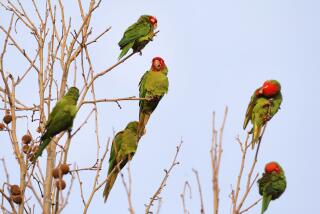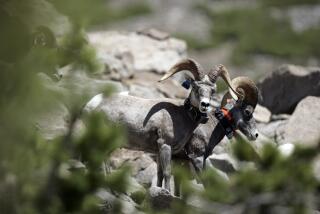WINGS OF DESIRE : Hunters Search Rocky Ridges Near Top of Eastern Sierra Looking for the Elusive Ptarmigan
- Share via
TOMS PLACE, Calif. — Finally, it’s ptarmigan ptime in the Eastern Sierra, so there are some things you need to know. Ptarmigan ptips, as it were.
First, the p is silent, somewhat like the birds. In fact, they’re so inaccessible, inscrutable and invisible that few Californians have seen one.
White-tailed ptarmigans, whose feathered legs place them in the grouse family, were transplanted to California from Colorado 18 years ago, and last weekend marked the opening of the state’s first legal hunt. Fifty hunters drawn from 88 applicants are being permitted to stalk the pigeon-size creatures this season and, frankly, the Department of Fish and Game didn’t expect many to be successful. The birds live in high elevations where trees don’t grow and roads don’t go--ptarmigan pterritory.
John Massie, the DFG’s assistant coordinator of upland game, said: “I don’t think many people realize how much of a commitment they’ve bitten off here. I would not be surprised if we had as few as a dozen birds taken. Getting the bird isn’t going to be the challenge. Getting to the bird is . . . up there to 10, 11 or 12 thousand feet and having time left to look for ‘em.”
Rick LaBorde, lead wilderness ranger for the Mono Lake District, said: “There’s plenty of ‘em, spread over 60 miles. But you can’t hunt ‘em from a car.”
As of Tuesday morning, Massie said he hadn’t heard from any hunters other than the two parties consisting of DFG employees.
“We had two parties out there and one got skunked and the other got their limit (in the Tioga Pass area), so right now as far as I know hunter success is 50%,” he said.
This small, historic settlement along U.S. 395 is at the southeast corner of the state’s only legal hunting area in Mono and Alpine counties. From here, at 7,000 feet, it’s at least a 3,000-foot climb to where the birds are. LaBorde recommended gaining as much elevation as possible by driving up the Tioga or Sonora passes farther north before setting out on foot.
Clait Braun, program leader for birds in the Colorado Division of Wildlife, had this advice: “The place to look is the snowfields. If you don’t have any snowfields, find the last area to melt out. If you can’t find where the snowfield was, work the rocky areas up high where there’s moisture. It’s got to be at or above tree line. Hunt in moist areas . . . any place there’s a little trickle of water, a real rocky area with some green vegetation, and the higher the better.
“The birds are clumped during the hunting season in flocks from four or five to 15 or 20, sometimes up to 40. I would guess the east side of the ridges would be better than the west sides, which tend to be drier.”
Ptarmigans are non-migratory and have excellent camouflage that changes with the season, first to blend with rocks, then snow.
“They’re going to be about three-quarters gray and a quarter white,” Braun said. “But they’ll have the white wings and tail, and their underbelly will be completely white. By the end of September they’ll be three-quarters white.
“If you get an early snowstorm, don’t pass up the snowdrifts, because these birds roost in ‘em. A lot of people have walked right by and had ‘em flush behind ‘em.”
Kelly Brumfield of the Rock Creek Pack Station up the road from Toms Place said she saw some ptarmigans at 11,200 feet--about three hours by horse or a four-hour hike.
“They shot right out of the willows . . . scared the heck out of my horse,” she said.
Braun said: “When you flush them, they’ll prefer to run rather than fly, because they don’t recognize ground predators. Their biggest fear right now is being eaten by something that flies. But on nasty days, their whole behavior changes because there aren’t many raptors (hunting birds) flying around.
“The best time to hunt them--when it’s most sporting--is a windy day with a little snow falling. The birds are calling. They’ll flush readily. If they get up in the wind you can’t even touch ‘em, unless you’re really a good shot.”
Braun said that about 1,500 hunters bag about 3,000 ptarmigans in the Rocky Mountains each year. Some use dogs--if the dogs are willing.
“It depends on your dog,” he said. “A dog that’s in condition is all right. The problem with dogs at high altitude is that they’ll quit early, and their feet get sore in the rocks.”
Jean M. Auel wrote of ptarmigans in her novels on prehistoric Europe.
In “The Mammoth Hunters:” “ . . . a pair of ptarmigan, their mottled summer plumage not yet fully changed to winter white.”
Some 30,000 years later, Braun trapped the original 73 birds that were sent to California over a two-year period starting in 1972. His California counterpart then was Harold Harper, in charge of the state’s upland game program.
Harper, now retired in Sacramento, recalled the time.
“Clait (Braun) was out here and said the Sierras looked pretty good for white-tailed ptarmigan. So I said, ‘What would you want for trade?’ Mountain quail, I think it was.
“Catching a ptarmigan is not too much of a problem. They lasso ‘em with a fishing rod with a noose on the end. Sometimes you can pick ‘em up by hand.”
(Auel, in “The Clan of the Cave Bear:” “The low-flying, heavy birds, easily brought down with stones from the marksman’s sling . . . “)
Lacking a sling, Braun recommended using a 16- or 20-gauge shotgun with size 7 1/2 or 6 low-velocity shot.
The first shipment to California was about 30 birds.
“We took ‘em over to Bridgeport,” Harper said. “To get up in those high mountains is quite a chore. We tried dropping ‘em from our (DFG) airplane. We’ve done that with turkeys, chukars and other birds. First we tried one bird. It didn’t work. The bird didn’t open its wings.
“Well, we thought, we won’t risk anymore. So we put ‘em on pack mules and packed ‘em up to the top of the mountain and turned ‘em loose.”
A few years later Harper sent some young department personnel up to see how the ptarmigans were surviving.
“They found ‘em, by gosh,” Harper said. “Found some broods. They’re very difficult to see. You can look right in a rock pile and all you’ll see is a little black eye. I don’t know how much success they’re going to have hunting ‘em, but there’s a fair-size population now.
The limit in California is two per day and per season. In Colorado it’s three. The birds have been transplanted to high elevations in other Western states but are hunted heavily only in Colorado.
“It’s not something that’s going to appeal to the average person from the coast,” Braun said. “If you dash up to the high country, unless you’re a fitness nut, you’re going to be out of shape and that first half-mile will kill you . . . well, it’ll make you huff and puff.”
LaBorde said that once a hunter has spent a few hours hiking into a proper area, he has to keep walking to find ptarmigans.
“You can’t find ‘em with a scope. You gotta walk and stir ‘em up.”
Is all the effort worth it?
“It’s going to be a trophy type of situation,” Braun said. “They are good eating. They’re a dark-meat bird. Because they don’t do a lot of flying, they aren’t muscular . . . they’re like the blue grouse.”
Ptarmigans feed on dwarf willow, an Alpine ground cover, which has about reached its limit for the population.
Massie said: “This is real typical of wildlife in general, that it expands until something limits it, and the limit here appears to be its food supply. We need to take some birds out of there.”
Which may be easier said than done.
More to Read
Sign up for The Wild
We’ll help you find the best places to hike, bike and run, as well as the perfect silent spots for meditation and yoga.
You may occasionally receive promotional content from the Los Angeles Times.






